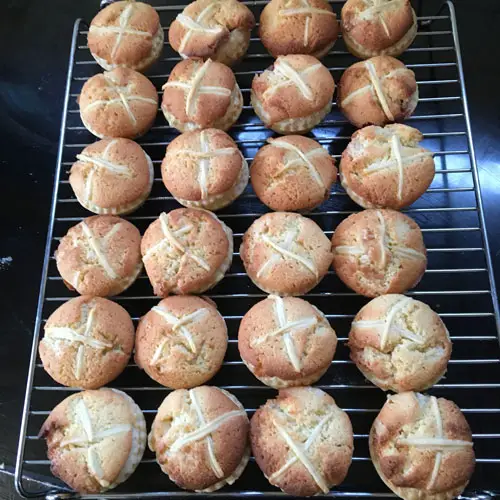December 13
Maids of Honour Tarts: A Taste of Christmas Past
Thank you for this page from Owen Emmerson who is a doctoral researcher at the University of Sussex, researching the history of childhood, corporal punishment, and emotion in twentieth-century Britain. He blogs at https://headmasterrituals.wordpress.com/, tweets at @MowenEmmerson and works at Hever Castle, Anne Boleyn'’s childhood home.

Christmas, for many, is a time for nostalgia and tradition. It is a time when family and friends gather to recreate a familiar experience, often underpinned by long accustomed activities, tastes, and smells. Inevitably, this period of purposefully-sought continuity is met with change, as new members and new children arrive, as those children grow older and spend their Christmases with other families and as the older generation sadly depart. Although the shifting rhythm of family life alters the reality of what each Christmas will bring, it is often the emotional draw of the past that people seek to recreate each year. This sense of nostalgia may be conjured through the smell of pine needles or mince pies, or the familiar sound of Christmas songs. For me, Christmas wouldn’t be Christmas without my Great-great Aunt Ethel’s Maids of Honour Tarts. I’m going to tell you a little about the illustrious history of these mouth-watering little festive treats, about why they are so much a part of my Christmas and I’m going to share with you two recipes for you to try.
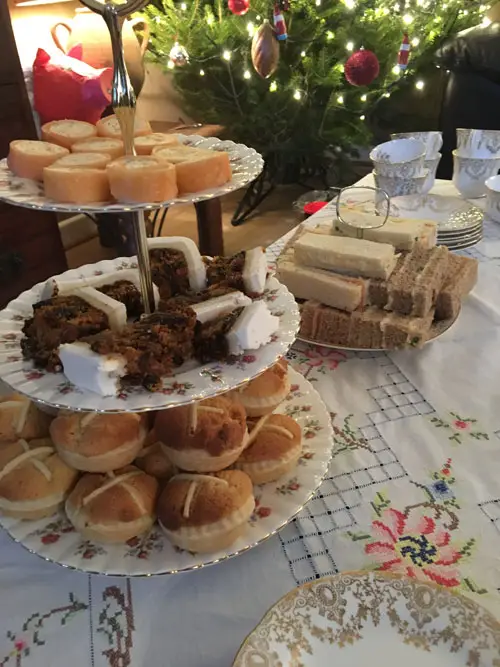
These small frangipane and raspberry jam cakes, encased in a light puff-pastry case, contain all the nostalgic ingredients to instantly take me back to Boxing Days past. My Auntie had baked these delicious delicacies when she was employed in service as a cook at Wickenden Manor in the early 1920s, and she loved nothing better than to bake us for them at Christmas each year. In many ways, Auntie was the best friend that I ever had. She looked after me as an infant when my parents were working, and I used to call in to see her in her every morning and every evening when I went to school. Her ‘upstairs downstairs’ stories ignited my love of social history, and we loved nothing more than putting on old BBC TV historical dramas that I would borrow for us to enjoy from the library each week. When she sadly died in 2004, our Christmases inevitably changed. I’d never had a Christmas without her before, and it took a fair few years for me to adjust to this change. Boxing days were especially hard to negotiate, and it wasn’t until last year that we decided to re-introduce Aunties tea-time treats back into our Christmas routine. After she died, I had researched the roots of her signature dish and was amazed to find that they purportedly originated from the court of Henry VIII, and had connections to none other than Anne Boleyn. I had been fascinated by Anne from a very young age and one of mine and Auntie’s favourite films to watch together had been ‘Anne of the Thousand Days’. It made me smile that these two influential characters in my life were somehow tied together by this evocative, delicious little cake, and sad too that I couldn’t tell her about the connection.
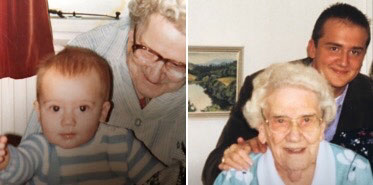
Although the tart had evolved into a jam-filled frangipane cake (rather like a Bakewell Tart), the original Tudor tart was filled with a sweet curd cheese filling, flavoured with spices and lemons, with a consistency not unlike a cheesecake. The legend goes that Henry VIII happened upon Katherine of Aragon’s ladies-in-waiting (or maids of honour) eating tarts from a silver plate at Richmond Palace. The queen’s most alluring maid, Anne Boleyn, offered up one of the tasty tartlets to the king to try. On tasting the delicate melt-in-the-mouth pastry, Henry declared that the ‘Maids of Honour’ tarts were so fine that they should only be baked for Royal Consumption and confiscated the recipe; locking it in a box in his private apartments at his Palace of Richmond. One more extreme version of this tale claims that the maid who had baked the tarts was herself kept a prisoner and forced to create the kings new favourite sweet whenever he so commanded.
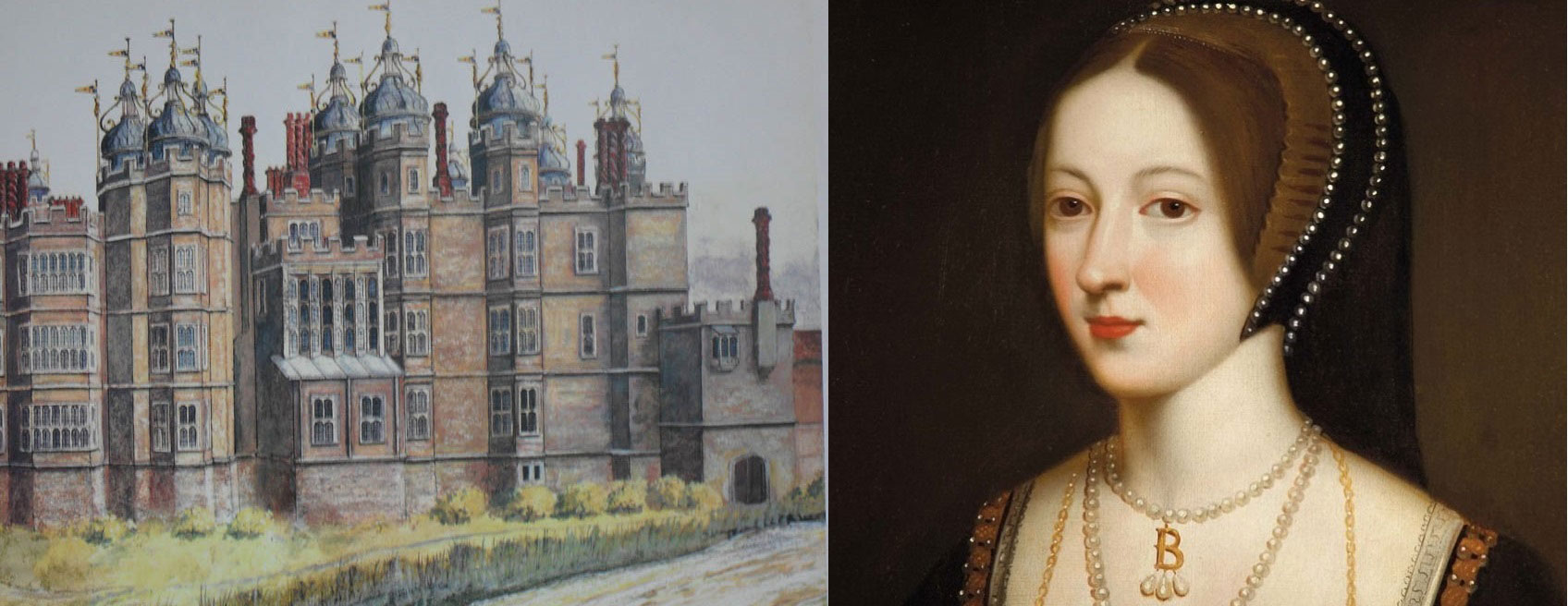
Whichever version of the tale is correct (and here’s hoping that it is the former) the first recorded recipe of the tart was published in the second edition of R. May’s ‘The Accomplisht Cook’ (1665). The Maids of Honor tart was then made commercially famous by Thomas Burdekin who claimed to have purchased the original recipe from the royal household. He opened a small shop next to the White Hart Inn in Hill Street, Richmond in 1750 where the tarts became a hit with the locals. The business was purchased by the Billett family in 1830, and Grandfather, father and son, in turn, welcomed the countless visitors who had made the almost mandatory pilgrimage to their Richmond ‘Maids of Honour’ shop. By the turn of the twentieth-century, the Billett family were selling no less than 8000 tarts a day.
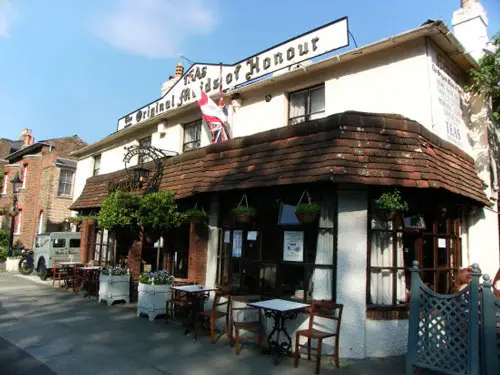
Robert Newens had served as an apprentice at the original bakehouse and opened his own establishment on the Kew Road in 1850. Although the original establishment closed in 1957, Newens ‘Maids of Honour’ Tea Rooms and Bakery is still open for business today, and whenever I visit the National Archives for historical research, I always visit to enjoy one of the famous tarts from the same original (and still closely guarded) recipe. Of course, other recipes for the tarts have been concocted over the years, and here is my favourite version of Anne Boleyn’s Maids of Honour tarts for you to bake and enjoy. I’ve also included a recipe for my Auntie Ethel’s Maids of Honour tart for you to try. Who knows, they may well become part of your Christmas traditions too.
Anne Boleyn's Maids of Honour Tarts
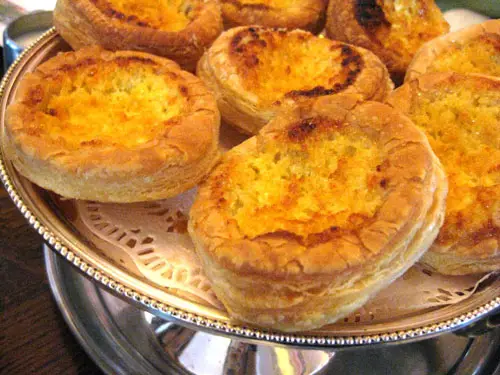
Ingredients
- 375g / 13oz puff pastry
- 50g / 1 ¾ oz softened butter
- 50g / 1 ¾ oz caster sugar
- 1 egg, beaten
- 1 tbsp plain flour
- 50g / 1 ¾ oz ground almonds
- ½ tsp grated nutmeg (or ground mace)
- Zest of two lemons
- 100g / 3 ½ oz curd cheese
Equipment
A twelve-hole (or two six-hole) baking tray and a 9cm / 3 ½ inch pastry cutter.
Method
- Preheat your oven to 180C/160C (fan)/ Gas 4.
- Roll your puff pastry out until it is slightly thinner than a one-pound coin.
- Cut out twelve 9cm/ 3 ½in round pastry disks and use to line your cake tray(s)
- Refrigerate the pastry-lined cake trays while you prepare the filling.
- Cream together the butter and sugar until light, pale and fluffy.
- Beat in the egg, flour, ground almonds, nutmeg (or ground mace) and lemon zest.
- Gently stir in the curd cheese. Be careful not to overwork the mixture here as it may split.
- Spoon the mixture evenly into the pastry cases.
- Bake for 25 minutes, or until the tarts have risen and are slightly brown on top.
- Remove tarts from the tray(s) and transfer to a wire rack until completely cool.
Ethel’s Maids of Honour Tarts
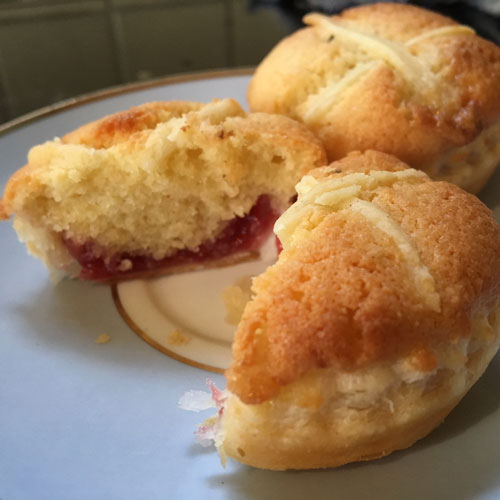
Ingredients
- 375g / 13oz puff pastry
- 125g / 4 ½oz butter
- 125g / 4 ½oz caster sugar
- 125g / 4 ½oz ground almonds
- 1 egg, beaten
- ½ tsp almond extract (or essence)
- Raspberry Jam
Equipment
A twelve-hole (or two six-hole) baking tray and a 9cm / 3 ½ inch pastry cutter.
Method
- Preheat your oven to 180C/160C (fan)/ Gas 4.
- Roll your puff pastry out until it is slightly thinner than a one-pound coin.
- Cut out twelve 9cm/ 3 ½in round pastry disks and use to line your cake tray(s). Save the offcuts of your pastry for decoration.
- Spoon in up to a teaspoon of jam into each of the tart bases and spread out evenly.
- Refrigerate the pastry-lined cake trays while you prepare the filling.
- Cream the butter and the sugar until light, pale and fluffy.
- Blend in the egg.
- Fold in the ground almonds and almond extract.
- Spoon the frangipane mixture on top of the jam-filled pastry tart cases, ensuring that the frangipane covers the jam and meets the sides of the pastry rim.
- With the pastry offcuts, cut thin strips and lay on top of the tarts forming a cross (similarly to that on top of a hot cross bun).
- Bake for 25 minutes or until the tarts are golden brown.
- Remove tarts from the tray(s) and transfer to a wire rack until completely cool.
